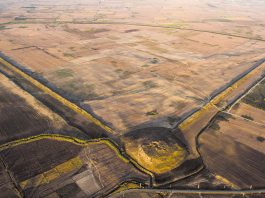Name
Dasht Qal’eh دشت قلعه
Ali Mousavi, April 26, 2023
Location: Situated in the Plain of Gorgān, northeastern Iran, Golestan Province.
37°10’36.8″N 55°14’23.2″E
Map
Historical Period
Iron Age, Sasanian, Islamic
History and description
Dasht Qal'eh is located about 80 km northeast of Gorgān and 8 km south of Gonbad-e Qābūs. It is a large walled site roughly triangular in shape (fig. 1). There are two mud-brick walls, one external and one internal, each measuring 4 and 6.75 meters high. A 55-meter-wide moat has been dug between the two walls, reaching 60 meters in some places. There is a circular mound covering 3 hectares, 20 meters high, at the southeast corner of the site. Excavations on the mound revealed the presence of a substantial building with massive piers in burnt bricks. Based on the ceramics, the building has been dated to the Ilkhanid period (13th – 14th century). Below the Ilkhanid building was a level of earlier occupation periods, such as Parthian and Sasanian. This level showed the same layout with burnt brick piers. Several Iron Age potsherds are found on the site, suggesting that the site was occupied in the first millennium BC. Later field work showed that the site was a densely populated Sasanian city in the fifth and sixth centuries A.D. At present, there is no archaeological evidence that Dasht Qal’eh was the ancient city of Syrinx, besieged by Antiochus III in 209 B.C. Geomagnetic survey of the site revealed the existence of monumental rows of pillars or colonnades streets, and millstones for food production.
Archaeological Exploration
Mohammad Yusef Kiani carried out excavations at Dasht Qal’eh on behalf of the Iranian Center for Archaeological Research in the spring of 1974. He opened a trench in the city wall, and two trenches on the site’s citadel or mound, and identified Dasht Qal'eh with the ancient city of Syrinx, the capital of Hyrcania. Later fieldwork and studies were carried out by a British-Iranian team on behalf of the Iranian Center for Archaeological Research and the Universities of Durham and Edinburgh under the direction of Jebrael Nokandeh, Hamid Omrani Rekavandi, Eberhard Sauer, and Tony Wilkinson between 2005 and 2009.
Finds
Architectural remains in mud-brick and burnt brick; glazed ceramics of the thirteenth/fourteenth century, typical plain and red ceramics of the Parthian period, and the Iron Age gray ware.
Bibliography
Kiani, M. Y., “Preliminary Report on the Excavations in Jorjān,” Proceedings of the IIIrd Annual Symposium on Archaeological Research in Iran, Tehran, 2nd-7th November 1974, Firouz Bagherzadeh (ed.), Tehran, 1975, pp. 117-136 (in Persian).
Kiani, M. Y., Parthian Sites in Hyrcania. The Gurgan Plain, Berlin, 1982, pp. 48-52.
Sauer, E. W., Omrani Rekavandi, H., Wilkinson, T. J., Nokandeh, J., Persia's Imperial Power in Late Antiquity: the Great Wall of Gorgan and Frontier Landscapes of Sasanian Iran, Oxford and Oakville, 2013, ch. 13 (for Dasht Qal’eh).



 DOWNLOAD AS PDF
DOWNLOAD AS PDF

















































































































